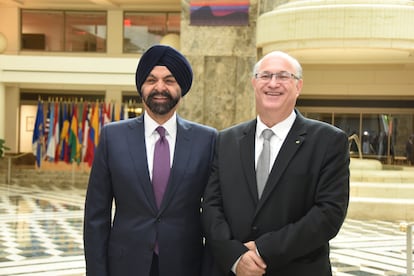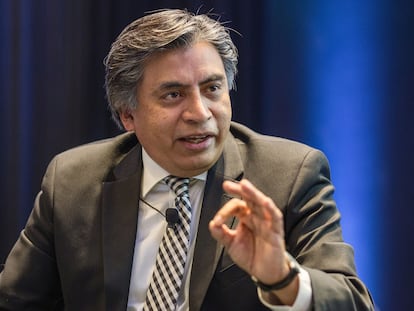The IDB and the World Bank join forces to promote development in Latin America
Ilan Goldfajn and Ajay Banga — the presidents of these international organizations — have signed a protocol of understanding. They want to work together to close the digital divide in the region and protect the Amazon and the Caribbean


The Inter-American Development Bank (IDB) and the World Bank have the same mission: to promote development. The two financial organizations overlap in Latin America and the Caribbean, where the IDB exclusively operates. Despite their common goals, they have a tradition in which they have frequently acted as competitors, with deep suspicion of each other. However, the two new presidents of these organizations ― Ilan Goldfajn of the IDB and Ajay Banga of the World Bank — have decided to join forces in the region.
Goldfajn and Banga signed a memorandum of understanding this past Tuesday at the IDB headquarters in Washington. The alliance will initially be for four years and will cover three areas: the protection of the Amazon, the strengthening of the Caribbean’s capacity to face natural disasters and the reduction of the digital divide throughout Latin America and the Caribbean (with a special focus on education).
Beyond the signing of the agreement, Banga and Goldfajn are friends. They know each other from the private sector, as well as from when Banga was in the financial sector and Goldfajn was the governor of the Central Bank of Brazil. Both have assumed their posts in the last year and, in both cases, they arrive with the mandate to work in a different way.
Even before this memorandum, the two men started working together. Last June, both visited Peru and Jamaica, where they met with Peruvian President Dina Boluarte and Jamaican Prime Minister Andrew Holness. “It was a historic trip. The first time that the two presidents [of these organizations] traveled together to the region,” Goldfajn emphasized.
At some point during that trip — while the president of the IDB was having coffee and the president of the World Bank was having a glass of wine — they began to talk about the need to collaborate more closely. And, during their conversations on the trip, they thought that the best way to put those good wishes into practice was to choose some topics that were important to both organizations. A few months later, the alliance in Washington was formalized.
Goldfajn and Banga have alluded to the magnitude of the challenges that lie ahead. “You can’t win alone. You have to join forces… and not only with multilateral banks, or with governments, but with civil society, philanthropy and the private sector,” Banga notes, explaining that both the problems and the possibilities of cooperation are intertwined.
“The reform of the multilateral banks is an opportunity to increase the impact on development,” Goldfajn affirms. “We have to focus on implementation. There are too many conferences, too many seminars.” He has called for a cultural change — one that consists of moving from words to actions. Goldfajn also wants there to be less importance attached to the amount of money put into projects and more on the impact generated.
In the Amazon, under the agreement signed, the organizations will combine their experience to support countries in their transition towards zero net deforestation, contribute to people obtaining better livelihoods and, at the same time, preserve the ecosystem. In the Caribbean, the agreement will result in increased support for countries to manage disasters and climate shocks, while allowing them to develop financial protection mechanisms should catastrophe strike.
The organizations have also committed to working together to promote digital development in the region. The action plan proposes that, through this collaboration, digital infrastructure and connectivity can be effectively expanded to help accelerate socio-economic development. Through the Connected Schools for All initiative, the World Bank and the IDB will develop plans to close the digital divide in education, ensuring that young people have the necessary skills for the economy of the future. An innovative pilot program will bring connectivity to underserved areas of the region, helping more people gain internet access, so as to expand opportunities.
In addition to the coordination agreement between the IDB and the World Bank, IDB Invest — the private sector arm of the IDB — and MIGA – the political risk insurance arm of the World Bank – have agreed to collaborate to mitigate political risk in the region. The two agencies will work together with the World Bank’s International Finance Corporation (IFC) to attract more private sector investment to the region.
Sign up for our weekly newsletter to get more English-language news coverage from EL PAÍS USA Edition
Tu suscripción se está usando en otro dispositivo
¿Quieres añadir otro usuario a tu suscripción?
Si continúas leyendo en este dispositivo, no se podrá leer en el otro.
FlechaTu suscripción se está usando en otro dispositivo y solo puedes acceder a EL PAÍS desde un dispositivo a la vez.
Si quieres compartir tu cuenta, cambia tu suscripción a la modalidad Premium, así podrás añadir otro usuario. Cada uno accederá con su propia cuenta de email, lo que os permitirá personalizar vuestra experiencia en EL PAÍS.
¿Tienes una suscripción de empresa? Accede aquí para contratar más cuentas.
En el caso de no saber quién está usando tu cuenta, te recomendamos cambiar tu contraseña aquí.
Si decides continuar compartiendo tu cuenta, este mensaje se mostrará en tu dispositivo y en el de la otra persona que está usando tu cuenta de forma indefinida, afectando a tu experiencia de lectura. Puedes consultar aquí los términos y condiciones de la suscripción digital.
More information
Archived In
Últimas noticias
Mexican peso defies uncertainty with forecasts of a new period of stability in 2026
Meghan Markle’s year of redemption: Numerous projects, some setbacks and a brand that is finally taking off
David King, chemist: ‘There are scientists studying how to cool the planet; nobody should stop these experiments from happening’
The end of the American dream gives way to Guatemalan opportunity
Most viewed
- Sinaloa Cartel war is taking its toll on Los Chapitos
- Oona Chaplin: ‘I told James Cameron that I was living in a treehouse and starting a permaculture project with a friend’
- Reinhard Genzel, Nobel laureate in physics: ‘One-minute videos will never give you the truth’
- Why the price of coffee has skyrocketed: from Brazilian plantations to specialty coffee houses
- Silver prices are going crazy: This is what’s fueling the rally










































